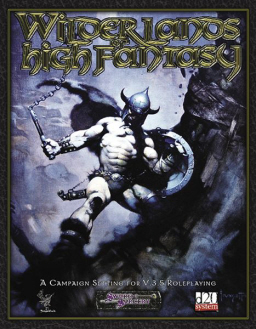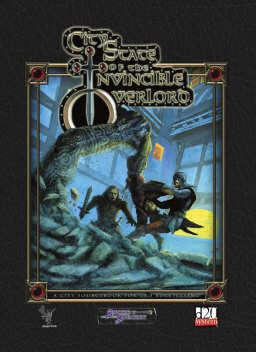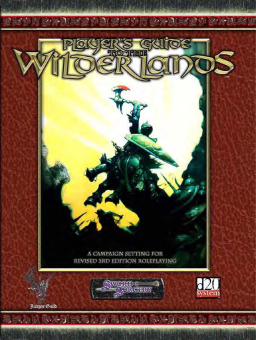New Treasures: Wilderlands of High Fantasy
 In the very early days of adventure gaming, there were two companies you could count on: TSR, creator of Dungeons and Dragons, and Judges Guild.
In the very early days of adventure gaming, there were two companies you could count on: TSR, creator of Dungeons and Dragons, and Judges Guild.
Judges Guild was admittedly second tier. While TSR was constantly innovating, with full color cover art and high production values, Judges Guild saw no reason to deviate from the look they established in 1976: rudimentary layout and typesetting, and two-color covers that looked torn from a coloring book.
But they were prolific. My weekly pilgrimages to the gaming store in 1979 rarely yielded a new TSR release — they were few and far between — but Judges Guild never let me down, and I went home satisfied with many a JG product tucked under my arm. At their peak in the early 80s, they employed 42 people and had over 250 products in print, an astounding output.
Judges Guild was founded by Bob Bledsaw and Bill Owen; their first major product (and claim to fame) was the City State of the Invincible Overlord. The ambitious setting for the City State — a massive 18 maps covering nine continents drawn from Bledsaw’s home campaign, ultimately used as the locale for numerous adventure modules — became their next major release: The Wilderlands of High Fantasy, the first licensed D&D product and the first true campaign setting for the game.
Wilderlands was different in other ways, too. Perhaps most importantly it had a true sandbox feel, rather than the tightly-focused adventures of Gygax and Co, in which players were expected to follow a linear path. It encouraged a wide-open style of gaming, focused on exploring vast and wondrous forests and rugged landscapes, rather than dungeon crawls.
As James Maliszewski aptly put it in his Grognardia post:
The Wilderlands of High Fantasy… [is] clearly designed to facilitate campaigns where the characters wander about the world, exploring it hex by 1056-foot hex, in search of fame and fortune according to their own lights rather than any overarching plan concocted by the referee beforehand.
 Judges Guild’s reluctance to update its look eventually doomed it however, as new companies like Chaosium, GDW and FASA arrived on the scene and grabbed a bigger piece of the role-playing pie. Its license to publish official Advanced Dungeons & Dragons titles expired in 1982, and its last major release was City-State of Tarantis in 1983, which vanished without a trace. Judges Guild was effectively out of business by 1985.
Judges Guild’s reluctance to update its look eventually doomed it however, as new companies like Chaosium, GDW and FASA arrived on the scene and grabbed a bigger piece of the role-playing pie. Its license to publish official Advanced Dungeons & Dragons titles expired in 1982, and its last major release was City-State of Tarantis in 1983, which vanished without a trace. Judges Guild was effectively out of business by 1985.
When the d20 publishing craze hit its peak in the late 90s, Bob Bledsaw reformed his gaming company and proved that Judges Guild could, after all, publish modern products with top-notch production values. In 2002, in partnership with Necromancer Games, Bledsaw and many of his original writers published substantially updated editions of The City State of the Invincible Overlord, the Player’s Guide to the Wilderlands, and a revised edition of Paul Jaquays’ classic dungeon crawl Caverns of Thracia.
Click on the image at right to see the cover for the revised City State of the Invincible Overlord, in all its wrap-around glory. The complete catalog of Judges Guild products from Necromancer Games, alongside new maps, fan material, and the freely downloadable A Street Guide to the City State of the Invincible Overlord, is here.
But the crown jewel of the new Judges Guild was a massive and gorgeous box set, a limited-run compilation that has become one of the most collectible RPG releases of the 21st Century: the Wilderlands of High Fantasy.
A huge expansion which still remains faithful to the spirit of the original, Wilderlands contains all 18 maps, with details on over 400 NPCs and monsters, and on more than 3,000 cities, villages, ruins, lairs, islands, citadels, castles, and strange geographic features.
Originally released at $69.99, it quickly went out of print, and new copies routinely sell today for between $200 – $285. I bought mine on eBay in 2007 — ironically, only after it arrived did I notice that the return address was for my friend Jolly Blackburn, creator of the Knights of the Dinner Table comic.
 The much smaller Player’s Guide to the Wilderlands, a 128-page paperback with a single map, is likewise just as collectible, with new copies selling north of $250.
The much smaller Player’s Guide to the Wilderlands, a 128-page paperback with a single map, is likewise just as collectible, with new copies selling north of $250.
In 2007 Judges Guild partnered with Goodman Games to release revised editions of three more early games for the growing Old School Renaissance market: The Thieves of Fortress Badabaskor, Citadel of Fire and Dark Tower, all updated for the d20 system. See their complete catalog of Judges Guild products here.
Unlike the earlier releases, all except Dark Tower are still in print and available at reasonable prices, and all three are available in PDF format at RPGNow and other fine outlets.
The work Bledsaw did with his various publishing partners was excellent, and it seemed like old-school gamers could look forward to a steady stream of nostalgic titles, finally given the professional editing and packaging they deserved.
Alas, it was not to be. Bob Bledsaw died of cancer on April 19, 2008, and Judges Guild vanished with him, this time apparently for good.
(Their website, packed with articles, maps, and free downloads, is still live here.)
This post is my salute to Bob, a man I never met, but whose passion for adventure gaming and whose unique approach to the hobby strongly influenced me for over three decades. I’m profoundly grateful for the contributions he made, and especially the beautiful editions released in the last ten years. Do yourself a favor and track them down — you won’t be disappointed.
Wilderlands of High Fantasy was published by Necromancer Games/White Wolf in 2005. It contains 18 poster maps and 445 pages of text, and was priced at $69.99. Yes, that’s a Frazetta cover. I’d offer more detail, but my copy is still in the shrinkwrap, and it looks like it’s going to stay that way. When I find one I can open, I’ll let you know.
What? A Frazetta cover that I haven’t seen before? Impossible.
Aonghus,
You’re right — it’s not possible. Probably not, anyway. This cover is recycled from Flashing Swords #1:
The colors have been substantially changed (probably digitally), but it’s the same art.
I began playing D&D in the mid-seventies. My buddy would buy TSR modules; I would get Judges Guild supplements/adventures. I even subscribed to Pegasus Magazine up to the last issue.
In the recently released (and OUTSTANDING) Kobold Guide to World Building, Wolfgang Bauer includes the following statement in the opening essay:
‘If everything is defined (somewhere), the GM has no latitude to invent his own material. If everything is documented, the GM needs to know and master those huge reams of material just in case the party goes there. There are no mysteries, and there is no room to maneuver.’
“No room to maneuver.” I love that! Don’t fill in every bit, as fun as it might be to think about and write.
I didn’t realize it at the time, but I do now: THIS principle was the genius of Judges Guild’s Wilderness setting. The guide books had very short descriptions of different places and left if up to the GM to flesh out and use. JG created a sandbox with limitless opportunities. They gave you the crayons and a bare bones map and said, “Go color it yourself.”
Frog God Games is run by Bill Webb, co-founder of Necromancer Games. They have a Necromancer feel to them. And, to a lesser extent, a Judges Guild vibe.
If you enjoyed Tegel Manor (which Necromancer had contracted to redo, but then JG pulled the plug on products), Frog God’s The Black Monastery is very much like it.
And Frog God has a product line called Hex Crawl Chronicles: it’s more than a spiritual successor to the Wilderland’s approach.
I picked up several JG products on eBay in the late ’90s and cycled them through eBay again a decade later. Some good bits and pieces here and there, but overall not my thing. It would have been interesting to compare the originals and the updated versions side by side to see how they’d changed.
I’ve been through a few JG modules on the player side, but they were heavily modified. (The Tegal Manor my PC lives in looks almost nothing like the original Tegal Manor.)
BTW: back around 1987, Mayfair Games re-did City State of the Invincible Overlord and issued some new supplements for it. They are hard to find: I’ve not read any of them.
They were for use with AD&D and TSR sued Mayfair for copyright infringement. Apparently Mayfair won and TSR bought the rights from them. Mayfair went under a few years later, resurfaced and is currently thriving as the English-language distributor of the Settlers of Catan franchise.
> THIS principle was the genius of Judges Guild’s Wilderness setting. The guide books had very short
> descriptions of different places and left if up to the GM to flesh out and use.
Sherlock,
Indeed. It encouraged two things, I think: an independence on the part of the game master, who naturally took ownership of the material, and adventures that took place over a vast landscape, since the players were encouaged to explore instead of arming up to delve into a dungeon.
When two game masters got together to compare Wilderlands sessions, it wasn’t about who managed to hew closest to the storyline. It was about who had shown the most creativity in responding to the unexpected directions their players took.
> If you enjoyed Tegel Manor (which Necromancer had contracted to redo, but then JG
> pulled the plug on products), Frog God’s The Black Monastery is very much like it.
You read my mind — I was just prepping a follow up article on the revised edition of TEGEL MANOR, which was announced but never published.
THE BLACK MONASTERY deserves a write-up all its own, though. I just read Bill Webb’s wonderful tale behind its release, which I think captures the communal experience of early D&D better than anything I’ve read in a long time:
http://www.talesofthefroggod.com/black.html
Thanks for the tip! Definitely need to check this out. And invite Bill to write for us someday. 🙂
[…] I was assembling my Judges Guild article on Tuesday, I stumbled on an odd reference to a revised version of one of their earliest (and most […]
I knew Bob. He was a great guy, a true gamer. The day I met him was the day that Necromancer released the Players Guide to the Wilderlands. I bought one of the first copies available for sale and still have it. I have everything Judges Guild published for the Wilderlands except for The City State of Tarantis, which I have (maybe) a line on getting a copy of, and Wraith Overlord, the mega-dungeon that was located underneath the City-State of the Invincible Overlord. I run OD&D Wilderlands games often.
Bob was generous and really wanted to get back into publishing RPGs towards the end of his life. I was glad I had an opportunity to thank him, for many fond memories of my youth, as well as sit on on a game he ran.
Bill Owen is alive and kicking. Currently he is in Belize working as a adventure guide leading tourists through the ancient Mayan ruins of Tikal. When he is Stateside he still games from time-to-time, mostly historical Navy miniatures.
> I picked up several JG products on eBay in the late ’90s and cycled them through eBay again a decade later.
> Some good bits and pieces here and there, but overall not my thing.
Jeff,
I think that’s part of what I was trying to communicate above (although not very well). A true love of JG products demands a high level of nostalgia, I think. You had to be someone who cherished it at a time when there was almost no other RPG products being written to understand.
That’s not to say that there weren’t some outstanding JG products (Caverns of Thracia, Dark Tower, and City State of the Invincible Overlord come to mind). But JG’s standards were several degrees lower than TSRs, and they produced some genuinely goofy products.
To love them as I do requires that you appreciate the bad with the good. If you weren’t a 16-year old gamer in 1980, desperately looking for a dungeon to run on Friday night, you probably won’t understand why I’m just as fond of some of their weaker products as I am of their acknowledged classics.
> BTW: back around 1987, Mayfair Games re-did City State of the Invincible Overlord and issued some new supplements for it.
> They are hard to find: I’ve not read any of them.
Sherlock,
Indeed they did. I’m surprised to hear they’re hard to find; for nearly two decades the Mayfair City-State releases cluttered up back stock boxes at every game store I hung out in.
Which was unfortunate — I thought they did a great job with them. Gygax contributed a fond introduction to the first one, if I remember correctly.
> I knew Bob. He was a great guy, a true gamer…
> Bob was generous and really wanted to get back into publishing RPGs towards the end of his life.
> I was glad I had an opportunity to thank him, for many fond memories of my youth, as well as sit on on a game he ran.
GameDaddy,
Thanks for sharing that. And I envy you your chance to meet Bob!
[…] for rare science fiction and fantasy collectibles — things like Judge’s Guilds epic Wilderlands of High Fantasy, Task Force Games’ colorful Swordquest, SSI’s wonderous Swords & Sorcery, and of […]
[…] John has written about Necromancer’s outstanding updating of Judges Guild’s Wilderlands of High Fantasy here. […]
[…] few years later, Necromancer Games would convert the campaign world, Wilderlands of High Fantasy, as well as City State of the Invincible Overlord and Caverns of Thracia, to third edition. Those […]